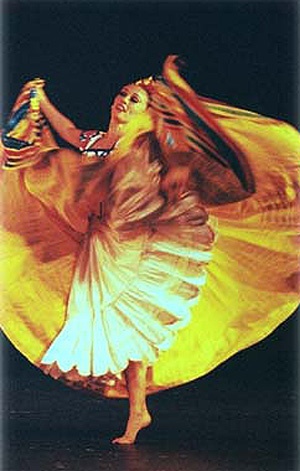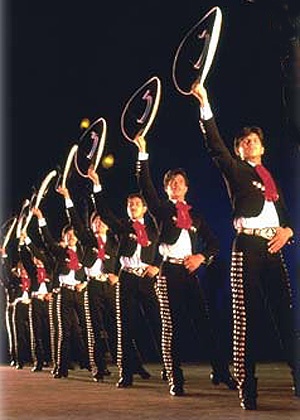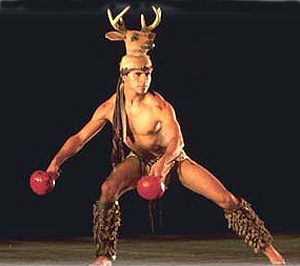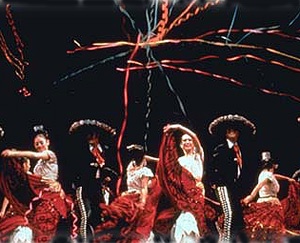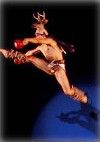Ballet Folklorico de Mexico at the Colonial Theatre
A cultural celebration in music, dance and costumes
By: Larry Murray - Oct 22, 2007
Ballet Folklorico de Mexico is more than a dance performance, it is two hours of celebration, a fiesta of music, costumes and dance that overwhelms the senses just as it overflowed the large stage at Pittsfield's gorgeous Colonial Theatre. After a weekend of enjoying the legendary fall foliage of the region, I was amazed how the colors on stage easily equalled even the best that Mother Nature can produce!
Dancer and choreographer Amalia Hernandez founded the company more than 50 years ago and has been keeping the folk traditions of Mexico alive for more than 50 years. From the moment the curtain parted and the huge company launched into "Matachines" the dancers flooded the stage with energy. First, one dozen. Then, two dozen. Three dozen. More and more, until the entire company was engaged in a dance whose ritual roots reach back to pre-Spanish times, supplemented with Medieval overtones from XVI Century Mexico.
The dance surged and crescendoed, taking the observers with it. The audience, culturally diverse but mostly conservative Berkshire types, quickly lost their detached coolness, and went wild with cheers and applause. The party had begun.
If the first piece had its origins in the northern part of Mexico City, the company was soon in the countryside, in the towns of Zirandaro and Altamirano, where the next three dances, Guerrero, Las Amaraillas and El Gusto (a tap dance) originated from. These were danced to live accompaniment on classical Mexican instruments, the combinations of which changed constantly through the evening.
The dance "Revolution" recalled 1910 and the famous soldaderas, the women who participated in the armed conflict in Mexico's fight for liberty. Peasant dances contrasted with European polkas, as aristocrats and farmers marched together to a new destiny.
Throughout the evening, ensemble work took precedence, with a couple of exceptions. The Charreada, or "Rope Dance" featured a tireless master of the lariat who kept his lasso going for a good 15 minutes. After many tricks, he roped in his intended, and the novelty piece gently merged into the more courtly "Country Love Dance" which portrayed flirting, courtship and engagement, Mexican style,
The first act finale brought us to the eve of January 31st and the celebration of the the Candelarla Virgin in the town of Tiacotalpan. On two platforms, symbolizing the stages the town erects each year, dancers launched into traditional fandangos, whose origins are clearly in the flamenco traditions of Spain. Stomping feet, upthrust arms, and "postura" permeate the proceedings as one dancer outshines the next. Finally come the mojigangas, enormous puppets that symbolize different cultural figures and archetypal human characteristics.
The music is dominated by the sounds of the congas and stomping feet, as the cast of characters overwhelms the stage and eventually overflows into the audience. The Angel, the Clown, the Moor, the Indian Girl and the Devil, The African Boy and La Jarocha, or woman from Vera Cruz all participate, involving even the audience.
After a while, they file back on stage, dancing and celebrating as they go and the audience finally gets a chance to catch its breath. Intermission however didn't diminish the energy.
When the curtains parted for the second half, the company topped itself again. "The Quetzals of Puebla" celebrates the mythic quetzal bird of Mesoamerica, and the incredible headpieces and costumes of the dancers leave no doubt as to why this bird was considered both beautiful and elegant, and sacred. The headdresses had to be six feet in diameter, and held to the top of the rapidly spinning dancers by gossamer threads and a cone shaped cap. I was in the tenth row and could feel the breeze created by the gigantic crowns as the dancers went through their paces.
After another outburst of approval from the audience, the company then contrasted the urban Danzon with its many Mexican rhythms such as La Habanera (Cuban) with the simpler Jarana (Spanish) traditions.
A story dance follows, that of the Wedding in the Huasteca. where a young rancher happens upon a young Indian girl and can't resist trying to romance her. Elsewhere, wedding preparations are underway, and all is festive until the groom's rival, who had been romancing the Indian girl, arrives and a machete fight erupts. The rival is killed, dragged off, and the party continues as if he never existed. Real life should be so simple.
In what was probably the only real solo tour de force of the evening, "Deer Dance" portrayed the hunt as seen by the Yaqui people. They are probably the only indigenous culture to have preserved their cultural autonomy in the face of Spanish colonialism. The Deer is the star here, portrayed by a dancer with antlers and little else to encumber his escape from the hunters and their arrows. The Deer Dance is still practiced today in Mexico, with hermetic fervor, by the descendants of this group, and it is said to bring luck and bountiful profit to all who participate. The program did not name the specific dancers for each role since they vary from performance to performance. The talented dancer who put his heart and soul into playing the deer received an ovation. He was simply that brilliant and touching.
Culminating the evening was dance from the state of Jalisco. This is where you find the familiar Carros, the Chinas and the Mariachis which have come to represent the very identity of Mexico. It seemed impossible, but the sensual music, refined dances and dazzling costumes of the entire evening were surpassed once again.
This finale opens with a traditional Mariachi parade playing lively sones as they do at the start of every fiesta. We get to see all the popular dances. The Snake, El Tranchete, La Negra and El Jarable Tapatio, and of course, the Mexican Hat Dance. As the performance ends, the dancers salute the audience with colorful paper streamers.
Applause, more streamers. More applause, more dancing, more streamers. After several rounds of this, and two standing ovations, the dancers and audience finally called it quits, and everyone reluctantly leaves for home, happy, exhausted, and exhilarated.
What a fiesta!
P.S. The only sad note was that Pancho's and Hot Harry's, the two Mexican restaurants nearest the theater were both oblivious to the Sunday evening diners on the way to the Colonial. They were closed, and only the lackluster Brazilian Buffet was open with a listless staff of one, and the manager, oblivious to the neglect of his customers, busy making plans for an empire of similar establishments, busy on his cellphone. Opportunities lost are a sad commentary on a usually astute Pittsfield business community.
Next on the Colonial's International Performance series are the Shaolin Warriors: Legendary Masters of Kung Fu on Sunday, November 25th at 4:00 p.m.
The Colonial Theater
413-997-4444
For the complete calendar of upcoming attractions, go to:
http://www.thecolonialtheatre.org/
Larry Murray is working on the Berkshire Fine Arts Holiday Preview 2007 which will appear here in mid-November. For more arts commentary by Larry Murray, you can also visit his Arts America blog at:
http://arts-america.blogspot.com/

